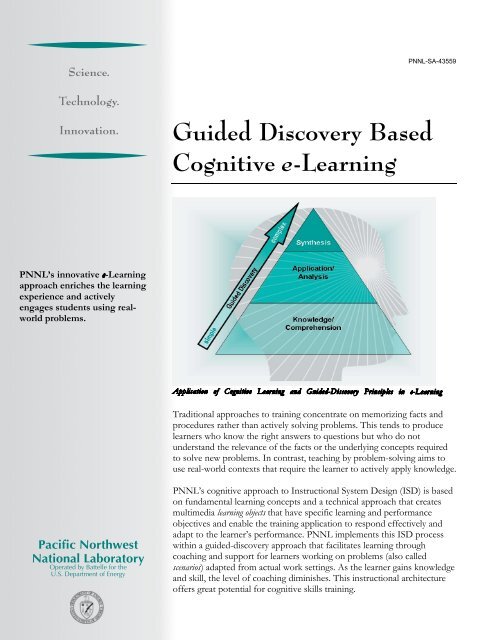Guided Discovery Based Cognitive e-Learning - Pacific Northwest ...
Guided Discovery Based Cognitive e-Learning - Pacific Northwest ...
Guided Discovery Based Cognitive e-Learning - Pacific Northwest ...
Create successful ePaper yourself
Turn your PDF publications into a flip-book with our unique Google optimized e-Paper software.
Science.<br />
Technology.<br />
Innovation.<br />
<br />
<strong>Guided</strong> <strong>Discovery</strong> <strong>Based</strong><br />
<strong>Cognitive</strong> e-<strong>Learning</strong><br />
PNNL’s innovative -<strong>Learning</strong><br />
approach enriches the learning<br />
experience and actively<br />
engages students using realworld<br />
problems.<br />
<br />
Traditional approaches to training concentrate on memorizing facts and<br />
procedures rather than actively solving problems. This tends to produce<br />
learners who know the right answers to questions but who do not<br />
understand the relevance of the facts or the underlying concepts required<br />
to solve new problems. In contrast, teaching by problem-solving aims to<br />
use real-world contexts that require the learner to actively apply knowledge.<br />
<strong>Pacific</strong> <strong>Northwest</strong><br />
National Laboratory<br />
Operated by Battelle for the<br />
U.S. Department of Energy<br />
PNNL’s cognitive approach to Instructional System Design (ISD) is based<br />
on fundamental learning concepts and a technical approach that creates<br />
multimedia that have specific learning and performance<br />
objectives and enable the training application to respond effectively and<br />
adapt to the learner’s performance. PNNL implements this ISD process<br />
within a guided-discovery approach that facilitates learning through<br />
coaching and support for learners working on problems (also called<br />
) adapted from actual work settings. As the learner gains knowledge<br />
and skill, the level of coaching diminishes. This instructional architecture<br />
offers great potential for cognitive skills training.
<strong>Cognitive</strong> Approach to<br />
Instruction<br />
PNNL’s cognitive approach:<br />
Engages learners to solve realworld<br />
problems, progressing<br />
from simple to complex<br />
Relates material to previous<br />
experience<br />
Demonstrates (rather than<br />
telling) what is to be learned<br />
using interactive, problemcentered<br />
activities<br />
Requires learners to use their<br />
new knowledge to solve<br />
problems (guiding the learner<br />
with feedback and coaching early<br />
and gradually withdrawing this<br />
support as learning progresses)<br />
Encourages learners to use the<br />
new knowledge in relevant<br />
applied settings.<br />
<br />
<br />
<br />
<br />
<br />
<br />
<br />
<br />
<br />
<br />
<br />
<br />
<br />
<br />
<br />
<br />
<br />
<br />
<br />
Technical Approach to<br />
Interactive Multimedia e-<br />
<strong>Learning</strong><br />
To employ effective multimedia<br />
content, PNNL’s technical approach:<br />
Assesses requirements to identify<br />
effective educational styles<br />
Defines desired media formats<br />
and training delivery styles<br />
Develops prototype simulations<br />
Develops an interface to pass<br />
performance data back to the<br />
<strong>Learning</strong> Management System<br />
Develops extensions, templates,<br />
and plug-ins to facilitate<br />
integration of interactive media<br />
elements.<br />
<br />
<br />
<strong>Guided</strong> <strong>Discovery</strong><br />
<strong>Learning</strong> Application<br />
PNNL used cognitive learning and<br />
guided-discovery concepts to design<br />
and develop an -<strong>Learning</strong> application<br />
for training Department of Energy<br />
Security Incident Inquiry officials on<br />
human errors that contribute to<br />
security incidents. A sample<br />
ESTHER -<strong>Learning</strong> screen is shown<br />
above. The guided discovery process<br />
takes learners from the simple to<br />
complex (both in terms of complexity<br />
of tasks and cognitive concepts) and<br />
provides multiple levels of feedback<br />
that implement varying degrees of<br />
coaching.<br />
The learner reads a description of the<br />
incident and virtually explores the<br />
workplace where the incident<br />
occurred. This includes a reenactment<br />
of the incident in the<br />
“Examine” tab; testimonies by coworkers<br />
(in the “Listen” tab); and<br />
available written documentation such<br />
as email (in the “Read” tab). After<br />
initially responding with basic<br />
observations, advanced learners are<br />
required to fill out a Web-based<br />
incident reporting form.<br />
Impact of This R&D<br />
PNNL’s -<strong>Learning</strong> research aims to<br />
create dynamic, interactive instructional<br />
environments that more closely<br />
represent real-life, “hands-on” training—achieving<br />
a level of interactive -<br />
<strong>Learning</strong> that is absent in the market<br />
today. Through its cognitive-based<br />
guided-discovery approach to<br />
instruction, PNNL is providing<br />
innovation and leadership in<br />
computer-based cognitive skills<br />
training.<br />
As a U.S. Department of Energy multiprogram<br />
national laboratory, PNNL develops<br />
and deploys technology for national missions<br />
in energy, the environment, defense, and<br />
human health.<br />
For more information,<br />
contact
















